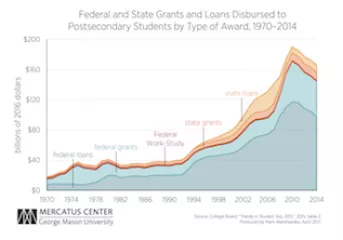Top schools should actually admit more relatives of wealthy alumni and use the money to expand their reach.
The topic of legacy admissions at top U.S. colleges seems to represent an anti-egalitarian perpetuation of privilege, a kind of affirmative action for the wealthy that must be stopped. In reality, the acceptance of students who are close relatives of previous attendees is where top schools make their money. These schools should take in more legacies, provided they put the extra money to good use.
Consider the economics of a top school, using Harvard College as an example. Last week it was revealed that more than 30 percent of surveyed members of the Class of 2021 are legacy admissions. In a typical year, Harvard’s operating costs are $4.7 billion. Undergraduate tuition covers only 6.4 percent of that total, and graduate tuition covers only 11.2 percent. Federal grants were $842 million in fiscal 2016, but much of that money is absorbed in research expenses (and that sum may decline under Donald Trump’s administration).
Basically, billions of dollars in expenses need to be covered each year. Donations -- and the return on investing the donation-based endowment -- are essential for making ends meet. Legacy admissions tend to come from wealthy families, and from families that have a tradition of donating to Harvard, if only to help their children get in the door. More legacy admissions will mean more resources at Harvard’s disposal. In short, why not expand the profit centers of America’s top universities?
Of course, if the elite schools are going to grow, the new activities should be geared less in the direction of wealthy people. As it stands, some of the top U.S. schools (not Harvard) take in more students from the top 1 percent of the income distribution than the bottom 60 percent. More generally, most attendees at top schools come from well-off families, and only 3 percent come from the bottom economic quartile.
To create momentum in the opposite direction, imagine a Harvard that admits more than 2,000 or so undergraduates, making further effort to identify individuals from lower-income or other backgrounds that do not describe the typical Harvard attendee. Or Harvard could open a branch for part-time study, and for Harvard certificates, but based in and serving one of the poorer neighborhoods of Boston. Alternatively, Harvard could do more internationally, focusing on the talent from poorer communities.
If need be, those initiatives could be named after donors who ponied up large sums of money to help get their kids into Harvard. And some portion of the money could be spent on those newly admitted rich kids too, just to make sure everyone is on board.
So why don’t top schools do more to expand their reach? No one doubts that they could find many more qualified students to admit. But there are two problems, both of which we should be willing to live with. First, expanding the size of top schools would lower faculty standards on the research side. That said, teaching quality is unlikely to suffer, as Harvard doesn’t select for the very best teachers. In any case, Harvard’s best researchers could continue their highly productive efforts without missing a beat. Second, administrators would face headaches and potential reputational liabilities from the new initiatives. But that is true in any kind of startup endeavor, and it isn’t a reason to remain stuck in the past.
The actual constraint on how big top schools could grow is how many eligible donors they can find and cultivate, if only through admitting their children. One question is how many such donors there are period, but in an age of high income inequality it seems America’s top schools have hardly tapped out this pool. Legacies make up a sixth of undergraduates at the University of Pennsylvania. A more unfortunate reality is that some donors might limit their support if say Princeton offered them and their children a less tony and exclusive experience. If that attitude can be overcome, America’s top schools could grow a great deal larger and more diverse.
We’re not going to find out where those constraints bite until we start with some experiments. It’s hard to believe that America’s top schools are not exclusive enough, so let’s have a few scale up their entering freshman classes very rapidly. And let’s have extra legacy admissions -- or rather some of the wealthy parents -- foot the bill.
